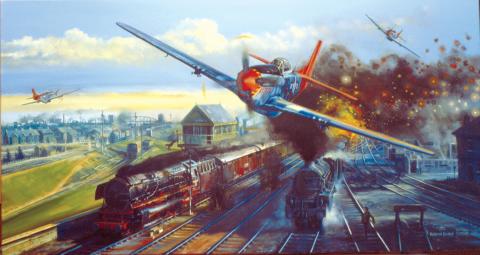Robert Bailey created this painting which illustrates 1st Lt. Charles E. McGee—a Tuskegee Airman—on a bomb run near Vienna during WWII. Firing 50-caliber bullets at a train with many box cars, McGee's six guns (on his Mustang) connected with ammunition on board the train. Mustangs following in McGee's wake were forced to climb in order to stay clear of the debris and shrapnel. Copyright, Robert Bailey, all rights reserved. Image provided here as fair use for educational purposes and to acquaint new viewers with Bailey's aviation artwork. Click on the image for a much-better view.
Even while risking - and giving - their lives for their country, the men of the 332nd Fighter Group faced ongoing discrimination against African-Americans. They had to fight to be given the chance to fight. They had to fight to be given the chance to fly. They had to fight to be given the chance to fly in combat.
Beyond all of that, they had to convincingly answer two important questions posed by the Tuskegee Experiment:
Did African-Americans have the will and ability to fly - and - could they successfully handle combat missions?
Paving the way for others who followed, the Tuskegee Airmen not only proved their abilities, they impressively handled combat missions.
In all, the Tuskegee Experiment graduated 650 single-engine pilots; 217 twin-engine pilots; 60 auxiliary pilots and 5 pilots from another country (Haiti). Who were some of their leaders?
- Lt. Earl R. Lane
More significant than their impressive statistics for shot-down German planes, the Red Tails and their escort missions saved thousands of lives.
Pilots on bomb runs had to keep their planes flying straight and level while they dropped their ordnance onto enemy targets. At the mercy of fighter planes (in the sky) and anti-aircraft fire (from the ground), bomb crews were always vulnerable. So good was their protection from the Red Tails, however, that only twenty-five of those escorted bombers were lost in aerial attacks.
During the war years, the Tuskegee Airmen found their own way to answer the claims of people like Spike Momyer. Herbert Carter summarizes their approach:
The best antidote to racism is excellence in one's performance.
With the actual performance of Tuskegee's Airmen in view, President Truman issued Executive Order 9981 (on July 26, 1948). In a single document, he ended the standard practice of racial inequality in America's military.
All along, many of the Tuskegee Airmen knew they were fighting two simultaneous battles - one for their country, the other for their race. They called it the "Double Victory."
At the end of the war, they had helped to prevail in both. As Lt. Col. William H. Holloman (retired Tuskegee Airman) observed:
America's not perfect. But I'll hold her hand until she gets well.


 Back
Back
 Next Chapter
Next Chapter

 Back
Back



